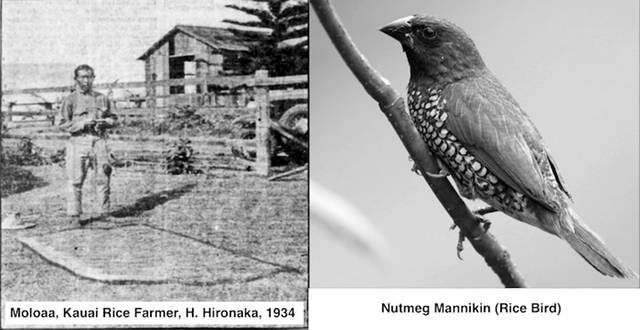Rice cultivation in Hawaii began in the mid-1860s, when Chinese farmers first started planting it in vacant taro patches. Production increased thereafter, so that by 1887, Hawaiian rice exports reached 13 million pounds, and in 1899, territorial rice production ranked
Rice cultivation in Hawaii began in the mid-1860s, when Chinese farmers first started planting it in vacant taro patches.
Production increased thereafter, so that by 1887, Hawaiian rice exports reached 13 million pounds, and in 1899, territorial rice production ranked third in the United States behind Louisiana and South Carolina.
But, its decline commenced soon afterwards during the early 1900s, after California farmers utilizing mechanization began producing cheaper rice.
Mainland consumers consequently bought the less-expensive California rice and Hawaii’s farmers using more costly hand labor were thereby forced to reduce production or stop planting rice.
In Hawaii, Japanese immigrants of the time also contributed to the decrease in Hawaii’s rice output, since they preferred medium grain, imported California rice, even if it generally cost more than the long grain rice local Chinese farmers grew.
Another factor in the downfall of the rice industry in Hawaii was the damage wrought by rice birds introduced into Hawaii from the Malay Peninsula in the 1870s.
Large number of these birds could wipe out a farmer’s entire crop by devouring ripening rice grains.
Farmers chased the birds away, trapped them in nets and made loud noises with metal cans, shotguns and so forth, yet nothing they tried warded off rice birds entirely.
The University of Hawaii even attempted to revive rice production in Hawaii during the 1930s by awarding prizes of merchandise to farmers catching the most rice birds.
In 1933, Moloaa, Kauai rice farmer H. Hironaka fashioned a net in which he trapped a record 4,320 rice birds — all of which were consumed as food.
Hironaka would conceal his net beneath rice hulls and straw and bait it with rice kernels.
One end of the net was fastened to the ground by a pin and the other was attached to a cord.
He would hide at the top of a nearby tree and would pull the cord when rice birds gathered around the bait.
When he yanked the cord, the net would overlap, trapping the birds.
Rice is now cultivated experimentally in Hawaii.


